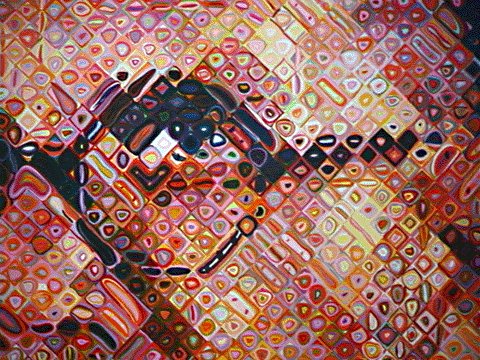Introduction
This assignment is an investigation of how artists since the beginning of the 20th century have been influenced by new media, such as photography, film, television etc rather than traditional painting. I have analysed works by the following three artists to consider this question:
Thomas Demand
Richard Prince
Chuck Close
Each is discussed below.
Thomas Demand
Thomas Demand was born in 1964 in Munich. He studied at the Akademie der Bildenden Künste in Munich, the Staatliche Kunstakademie Düsseldorf, and Goldsmiths College in London. He originally trained as a sculptor but has developed a photographic practice involving the construction of life-size models out of paper and cardboard. (Guggenheim, 2011)
The work I have chosen to study is Demand’s Corridor, 1995 Chromogenic process print with diasec. 183.5 x 270 cm. (below)

Corridor, 1995 Chromogenic process print with diasec. 183.5 x 270 cm by Thomas Demand
The work is a photograph of a paper model sculpted by Demand. The model is based on an original photograph, culled from the media. He most often chooses banal, yet historically relevant, photographs as his source material. Corridor for example represents the corridor outside the apartment of the American mass murderer Jeffrey Dahmer. When constructing the model, he carefully removes traces of human intervention in the scene. The finished sculpture is photographed using a large format camera and then destroyed.
On the face of it the work is a banal photograph of a corridor in a building. However when one looks closer something seems wrong. Everything looks too clean. There are no traces of human activity. There are points of detail missing – no switches on the light fittings and no handles on the doors. So just what is it that we are seeing? This is the question that Demand is posing. His work challenges our perceptions of the reality. The work of art is three times removed from the original scene it depicts. It is a photograph of a sculpture of a photograph.
He is also questioning how an artist is able to express their intentions through different forms of visual representation. In an interview with Alexander Kluge Demand comments ‘You can walk around a sculpture as often as you like, and with photographs – mine are very large so that, as with the sculptures, you can also walk around them – you have a moment and my particular angle of vision. My tyrannical condition, as it were, is that I prescribe your vision’ (Kluge, 2006). Essentially what Demand is saying is that by photographing his sculptures he is not only able to insist upon what we see but also how we see it. By so doing he makes his artistic intention absolutely clear.
Richard Prince
Richard Prince was born in 1949 in the Panama Canal Zone, then a United States territory. He moved to Boston in 1954. In 1973, after applying to the San Francisco Art Institute without success, he moved to New York, where he became familiar with Conceptual art. Working in the Time-Life Building as a preparer of magazine clippings, he became aware of the possibilities of advertising imagery and began to use this as the basis of his art. (Rosenberg, 2005)
One of his best-known works is Untitled (Cowboy), 1989 Chromogenic print 50 x 70 in. (127 x 177.8 cm). (below). What Prince did was to “re-photograph” an advertisement for Marlboro Lights, but removed the picture of the cigarette pack, the advertising copy (“The spirit of Marlboro in a low tar cigarette”), and the Surgeon General’s health warning. He produced a gallery-sized print of the photograph and represented it as a unique piece of art.

Untitled (Cowboy), 1989 Chromogenic print 50 x 70 in. (127 x 177.8 cm) by Richard Prince
In some senses Prince’s work references earlier work by Andy Warhol who produced images of boxes and cans of consumer goods. It is essentially a conceptual piece commenting on how the advertising industry hijacks and even creates American myths to sell consumer products. Prince believes his work is about photography and how photography is used. In a 1992 interview Prince stated ‘I mean I still think it was about how photography and certain media representations are like the Antichrist. It gets me angry, some of these representations, the way that media manipulates and doesn’t tell the whole story’. (Whitney, 1992).
By presenting in a large print for gallery exhibition he also forcefully demonstrates the importance of context is when photographs are read. A Marlboro advert in a magazine is easily overlooked, whereas a large photograph in a gallery commands attention.
Prince’s appropriation of photographs challenges the concepts of ownership and authorship. His work also probes how through photography the mythical status of cowboys, bikers, customized cars, and other icons have been used in the construction of American identity.
Chuck Close
Whilst American Chuck Close is a painter, he has clearly been heavily influenced by photography. He paints in a style known as photorealism that emerged in the USA in the late 1960s. It involves the making of a work of art, which is an exact recreation of an original object (in the case of sculpture) or photograph (in the case of painting). Close has been a leading artist in this field.
Close’s Big Self Portrait (1967-1968) is one of his early works and is a prime example of photorealism. (below)

Big Self Portrait (1967-1968) by Chuck Close.
To produce this portrait he made a photograph of himself onto which he drew a grid. He transcribed the content of each element on the grid onto a much larger canvas to produce the final painting. (ThinkQuest, 2011). The grid he used for Big Self Portrait was very fine and from a distance was not apparent to the viewer. From close up however the painting becomes more abstract. In a sense when viewed close up his paintings can be compared those of the abstract expressionists whose work had no clear focal point. On the other hand the realistic nature of the paintings viewed from a distance represented a move away from the abstraction of earlier artists.
The technique applied by Close is one which dates back to the Renaissance masters and was later also adapted by contemporary billboard painters. The process is important to Close. In his own words he has ‘embedded in the work itself is all kinds of information about how it got made’. Viewers can ‘decode the process and figure out what happened’. His paintings are also very large. His view on this is that ‘the bigger they are the longer they take to walk by’, indicating that he wants his work to be studied. (Kosters, 2010)
In 1988, Close had a spinal blood clot, which left him a quadriplegic, unable to move either his legs or his arms. Over time he recovered some use of his arms, but he clearly had to develop a new way to paint. His continued in his signature style of painting portraits of heads from source photographs which he now allowed his assistants to grid off. However, he moved away from exact replication of the elements in the grid towards a technique akin to pointillism as illustrated by this detail from a recent untitled self-portrait shown below. From a distance the subjects remain clearly recognizable.

Untitled Self Portrait (detail) by Chuck Close
Close does not like the terms “photorealism” and “superrealism”. In a recent interview he stated that he has always been “interested in the artificial as the real,” and that mark making has always been important to him. In his view it is this physicality that distinguishes painting from photography. (Kosters, 2010).
References
Guggenheim. (2011) Collection Online: Thomas Demand b. 1964, Munich. The Solomon R Guggenheim Foundation (SRGF). Available from:
http://www.guggenheim.org/new-york/collections/collection-online/show-full/bio/?artist_name=Thomas Demand&page=1&f=Name&cr=1
Kluge, A. (2006) Thomas Demand In Conversation with Alexander Kluge. Saatchi Online.
Available from:
http://magazine.saaatchionline.com/culture/reports-from/los-angeles-reports-from/thomas_demand_in_conversation [Accessed 30 November 2011]
Rosenberg, K. (2005) Artist: Richard Prince. New York Art. Available from:
http://nymag.com/nymetro/arts/art/11815/ [Accessed on 2 December 2011]
Whitney Museum of American Art. (1992) A Conversation with Richard Prince. American Suburb X. Available from: http//www.americansuburbx.com/2011/04/interview-conversation-with-richard.html [Accessed on 5 December 2011)
ThinkQuest. (2011) Chuck Close (1940-present). Oracle ThinkQuest Educational Foundation. Available from: http://library.thinkquest.org/C0118063/time/close.htm [Accessed on 1 January 2012]
Kosters, B. (2010) Interview with Chuck Close. Fnews Magazine, School of the Art Institute of Chicago. Available from: http://fnewsmagazine.com/2010/05/interview-with-chuck-close/ [Accessed on 1 January 2012]






